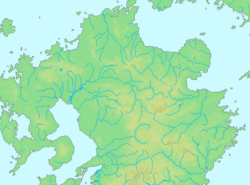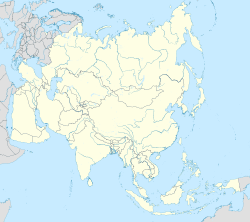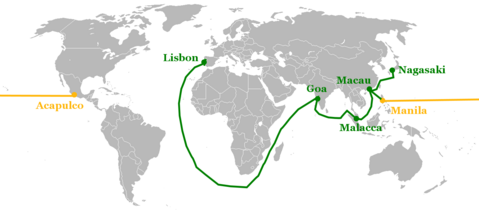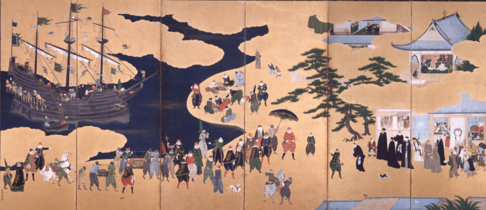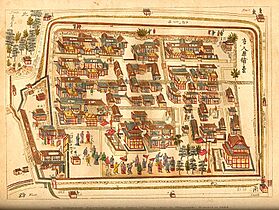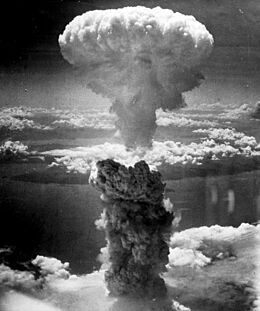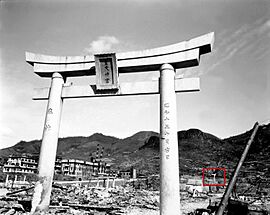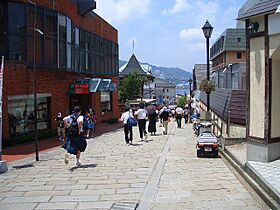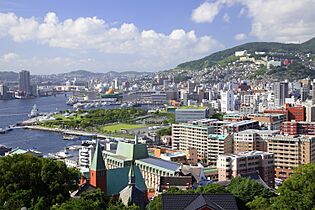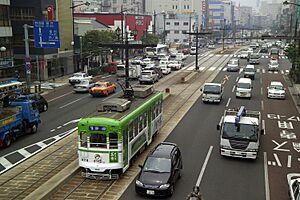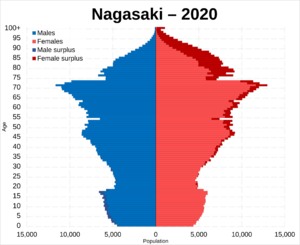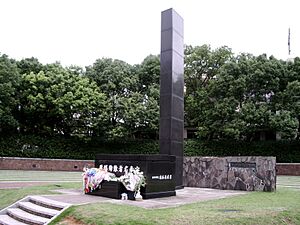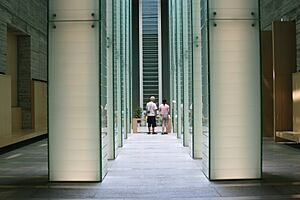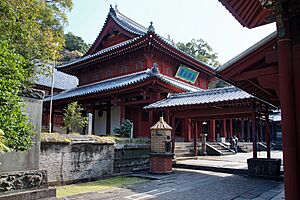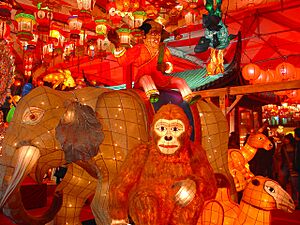Nagasaki facts for kids
Quick facts for kids
Nagasaki
長崎市
|
|||
|---|---|---|---|
|
Prefecture capital and core city
|
|||
| Nagasaki City | |||
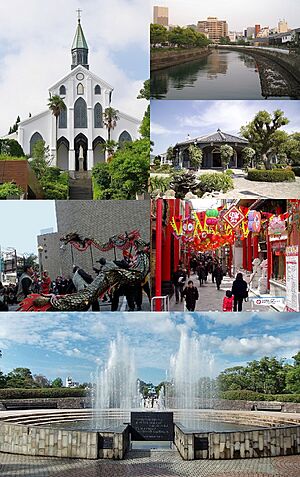
From top to bottom, left to right: Ōura Cathedral, Nakashima River, Glover Garden, Nagasaki Kunchi, Nagasaki Shinchi Chinatown, Nagasaki Peace Park
|
|||
|
|||
| Nickname(s): | |||
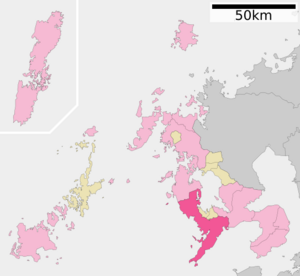
Map of Nagasaki Prefecture with Nagasaki highlighted in dark pink
|
|||
| Country | |||
| Region | Kyushu | ||
| Prefecture | Nagasaki Prefecture | ||
| Area | |||
| • Total | 405.86 km2 (156.70 sq mi) | ||
| • Land | 240.71 km2 (92.94 sq mi) | ||
| • Water | 165.15 km2 (63.76 sq mi) | ||
| Population
(February 1, 2024)
|
|||
| • Total | 392,281 | ||
| • Density | 966.543/km2 (2,503.33/sq mi) | ||
| Time zone | UTC+9 (Japan Standard Time) | ||
| – Tree | Chinese tallow tree | ||
| – Flower | Hydrangea | ||
| Phone number | 095-825-5151 | ||
| Address | 2–22 Sakura-machi, Nagasaki-shi, Nagasaki-ken 850-8685 |
||
| Nagasaki | |||||
|---|---|---|---|---|---|

Nagasaki in kanji
|
|||||
| Japanese name | |||||
| Kanji | 長崎 | ||||
| Hiragana | ながさき | ||||
|
|||||
Nagasaki (Japanese: 長崎, Hepburn: Nagasaki) (IPA: [naɡaꜜsaki]; lit. "Long Cape"), officially known as Nagasaki City (長崎市, Nagasaki-shi), is a major city in Japan. It is the capital and largest city of the Nagasaki Prefecture, located on the island of Kyushu.
Nagasaki was founded by the Portuguese. For a long time, from the 16th to the 19th centuries, it was the only port in Japan open for trade with Portuguese and Dutch ships. The city is also home to Hidden Christian Sites in the Nagasaki Region, which are recognized as UNESCO World Heritage Sites.
During World War II, Nagasaki became the second city in the world to experience a nuclear attack. After the war, the city was rebuilt and transformed. As of February 1, 2024, Nagasaki has about 392,281 people.
Contents
History of Nagasaki
Early Days: A Port for Trade
The first time Europeans came to Japan was in 1543. Portuguese explorers landed near Nagasaki. Soon, Portuguese ships began regular trade with Japan. This helped Japan connect with the rest of the world, especially Ming China, which Japan had stopped trading with. The Portuguese acted as middlemen.
However, there wasn't a good port in Kyūshū for foreign ships. This was a problem for merchants and local lords called daimyōs, who wanted to benefit from this new trade.
Nagasaki and Christian Missionaries
In 1549, a Jesuit missionary named St. Francis Xavier arrived in Japan. His followers converted several daimyōs to Christianity. One important daimyō was Ōmura Sumitada. In 1569, he allowed a port to be built in Nagasaki for Portuguese ships. This port officially opened in 1571.
Nagasaki quickly grew into a busy port city. Many Portuguese products, like tobacco, bread, and a sponge cake called castellas, became popular in Japan. Even Tempura, a famous Japanese dish, came from a Portuguese recipe. The Portuguese also brought goods from other Asian countries, like China.
Nagasaki Under Jesuit Control
Because of the unstable Sengoku period (a time of civil war in Japan), the local lord Sumitada and Jesuit leader Alexandro Valignano decided to let the Society of Jesus (Jesuits) manage Nagasaki. This was to protect the Christian city from non-Christian lords. So, for a short time after 1580, Nagasaki was controlled by the Jesuits. It became a safe place for Christians who were being treated badly in other parts of Japan.
However, in 1587, Toyotomi Hideyoshi, a powerful leader who was uniting Japan, arrived in Kyūshū. He was worried about the strong Christian influence. Hideyoshi ordered all missionaries to leave and took direct control of Nagasaki. But many people in Nagasaki continued to practice Catholicism.
Challenges for Christians in Japan
In 1596, a Spanish ship crashed off the coast of Japan. Hideyoshi learned that Spanish missionaries might be part of a plan to invade Japan. In response, he ordered 26 Catholics to be crucified in Nagasaki in 1597. These people are known as the "Twenty-six Martyrs of Japan". Despite this, Portuguese traders were still allowed, and Nagasaki continued to be a busy port.
When Tokugawa Ieyasu took power in 1603, Catholicism was still tolerated. But by 1614, it was officially banned. Missionaries were ordered to leave, and many Christian daimyōs gave up their faith. A harsh campaign against Christians followed, with many Japanese and foreign Christians facing severe consequences in Nagasaki.
The last major uprising by Christians was the Shimabara Rebellion in 1637. After this, Japanese leaders became very wary of foreign influences. This led to Japan's "national isolation policy". The Portuguese were completely expelled from Japan. They had been living on a special artificial island in Nagasaki harbor called Dejima. The Dutch traders, who had been based in another city, were then moved to Dejima.
-
Portuguese (green) and Spanish (yellow) trade routes to Macao and Nagasaki
-
Nanban trade by Kanō Naizen, c. 1600. This painting shows Portuguese merchants arriving in Japan.
Nagasaki During Japan's Isolation
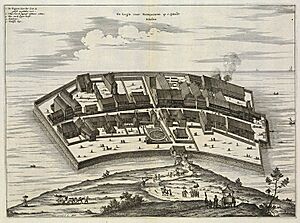
In 1663, a large fire destroyed much of Nagasaki. In 1720, the ban on Dutch books was lifted. This led many scholars to come to Nagasaki to study European science and art. Nagasaki became a major center for "rangaku", or "Dutch learning".
During the Edo period, the Japanese government controlled Nagasaki directly. While Nagasaki was an important port, Japan also traded with other countries through different regions. However, Nagasaki was often seen in art and stories as a lively port full of interesting things from the Western world.
In 1808, a British warship, HMS Phaeton, entered Nagasaki Harbor. The local officials couldn't stop the crew from demanding supplies. This incident led to stronger coastal defenses and stricter rules for foreign visitors. Chinese merchants also had a special walled area in Nagasaki, similar to Dejima.
Nagasaki in Modern Japan
With the Meiji Restoration in 1868, Japan opened its doors again to foreign trade. Nagasaki became a "treaty port" in 1859, meaning it was open for international business. Modernization began quickly. Nagasaki officially became a city on April 1, 1889. As Christianity was now allowed again, Nagasaki became a center for Roman Catholicism in Japan.
During the Meiji period, Nagasaki grew into a hub for heavy industry, especially ship-building. The shipyards, controlled by Mitsubishi Heavy Industries, built many ships for the Imperial Japanese Navy. Nagasaki harbor was also an important naval base.
Atomic Bombing of Nagasaki in World War II
Before the nuclear attack, Nagasaki had already been hit by several smaller air raids. These raids caused some damage and led many people, especially schoolchildren, to leave the city for safety. This reduced the population in Nagasaki at the time of the atomic attack.
On August 9, 1945, the population of Nagasaki was estimated to be 263,000 people. A US plane, the Bockscar, carried a plutonium bomb called "Fat Man". The main target was another city, Kokura, but it was too cloudy. So, the plane headed to Nagasaki.
Nagasaki was also covered by clouds. The crew had to use radar to drop the bomb. At the last moment, the clouds cleared slightly, and they saw a racetrack. They dropped the bomb in the city's Urakami Valley. The bomb exploded at 11:02 a.m.
The explosion destroyed the northern part of the city. More than 10% of the city's population died. This included many workers from the Mitsubishi factories. A large part of Nagasaki's industrial production was destroyed. This was the second and last time a nuclear weapon has been used in combat. The first was in Hiroshima three days earlier. The "Fat Man" bomb was more powerful than the one dropped on Hiroshima, but Nagasaki's hilly land helped reduce the damage.
Nagasaki Today
After the war, Nagasaki was rebuilt. The city focused on foreign trade, shipbuilding, and fishing instead of war industries. This plan was made official in 1949. New temples and churches were built, showing the return of Christianity. Some damaged structures, like a one-legged torii gate and an arch near the bomb's impact site, were left as memorials. New memorials, like the Nagasaki Atomic Bomb Museum, were also built.
Nagasaki is still an important port city with a strong shipbuilding industry. In 2005 and 2006, several nearby towns merged with Nagasaki, making the city larger.
Geography and Climate
Where is Nagasaki Located?
Nagasaki is located at the end of a long bay, which forms one of the best natural harbors on the island of Kyūshū. The main parts of the city are on a small flat area near the bay. Two rivers, separated by a mountain, create the two main valleys where the city is built. The city is surrounded by other cities and towns in the Nishisonogi District.
Nagasaki's Weather
Nagasaki has a humid subtropical climate. This means it has mild winters and long, hot, and humid summers. It is one of the wettest large cities in Japan. In summer, the heat and humidity can be intense. Winters are drier and sunnier than some nearby areas.
The wettest month ever recorded was July 1982, with 1178 millimeters (about 46 inches) of rain. The driest month was September 1967, with only 1.8 millimeters (about 0.07 inches). Rain falls throughout the year, but it rains the most in June and July. August is usually the warmest month.
| Climate data for Nagasaki (1991−2020 normals, extremes 1878−present) | |||||||||||||
|---|---|---|---|---|---|---|---|---|---|---|---|---|---|
| Month | Jan | Feb | Mar | Apr | May | Jun | Jul | Aug | Sep | Oct | Nov | Dec | Year |
| Record high °C (°F) | 21.3 (70.3) |
22.6 (72.7) |
24.4 (75.9) |
29.0 (84.2) |
31.4 (88.5) |
36.4 (97.5) |
37.7 (99.9) |
37.7 (99.9) |
36.7 (98.1) |
33.7 (92.7) |
27.4 (81.3) |
23.8 (74.8) |
37.7 (99.9) |
| Mean daily maximum °C (°F) | 10.7 (51.3) |
12.0 (53.6) |
15.3 (59.5) |
19.9 (67.8) |
23.9 (75.0) |
26.5 (79.7) |
30.3 (86.5) |
31.9 (89.4) |
28.9 (84.0) |
24.1 (75.4) |
18.5 (65.3) |
13.1 (55.6) |
21.2 (70.2) |
| Daily mean °C (°F) | 7.2 (45.0) |
8.1 (46.6) |
11.2 (52.2) |
15.6 (60.1) |
19.7 (67.5) |
23.0 (73.4) |
26.9 (80.4) |
28.1 (82.6) |
24.9 (76.8) |
20.0 (68.0) |
14.5 (58.1) |
9.4 (48.9) |
17.4 (63.3) |
| Mean daily minimum °C (°F) | 4.0 (39.2) |
4.5 (40.1) |
7.5 (45.5) |
11.7 (53.1) |
16.1 (61.0) |
20.2 (68.4) |
24.5 (76.1) |
25.3 (77.5) |
21.9 (71.4) |
16.5 (61.7) |
11.0 (51.8) |
6.0 (42.8) |
14.1 (57.4) |
| Record low °C (°F) | −5.6 (21.9) |
−4.8 (23.4) |
−3.6 (25.5) |
0.2 (32.4) |
5.3 (41.5) |
8.9 (48.0) |
15.0 (59.0) |
16.4 (61.5) |
11.1 (52.0) |
4.9 (40.8) |
−0.2 (31.6) |
−3.9 (25.0) |
−5.6 (21.9) |
| Average precipitation mm (inches) | 63.1 (2.48) |
84.0 (3.31) |
123.2 (4.85) |
153.0 (6.02) |
160.7 (6.33) |
335.9 (13.22) |
292.7 (11.52) |
217.9 (8.58) |
186.6 (7.35) |
102.1 (4.02) |
100.7 (3.96) |
74.8 (2.94) |
1,894.7 (74.59) |
| Average snowfall cm (inches) | 3 (1.2) |
0 (0) |
0 (0) |
0 (0) |
0 (0) |
0 (0) |
0 (0) |
0 (0) |
0 (0) |
0 (0) |
0 (0) |
0 (0) |
4 (1.6) |
| Average precipitation days (≥ 0.5 mm) | 10.4 | 10.2 | 11.4 | 10.3 | 10.1 | 14.3 | 11.9 | 10.7 | 9.8 | 6.7 | 9.5 | 10.2 | 125.6 |
| Average relative humidity (%) | 66 | 65 | 65 | 67 | 72 | 80 | 80 | 76 | 73 | 67 | 68 | 67 | 71 |
| Mean monthly sunshine hours | 103.7 | 122.3 | 159.5 | 178.1 | 189.6 | 125.0 | 175.3 | 207.0 | 172.2 | 178.9 | 137.2 | 114.3 | 1,863.1 |
| Source: Japan Meteorological Agency | |||||||||||||
Education in Nagasaki
Universities and Colleges
Nagasaki is home to several universities and junior colleges. These include:
- Kwassui Women's University
- Nagasaki Institute of Applied Science
- Nagasaki Junshin Catholic University
- Nagasaki University
- Nagasaki University of Foreign Studies
- Nagasaki Wesleyan University
- Nagasaki Junior College
- Nagasaki Junshin Junior College
- Nagasaki Women's Junior College
Economy of Nagasaki
Nagasaki's economy is focused on:
- Machinery and heavy industry
- Mitsubishi (a major company)
- Shipbuilding
Getting Around Nagasaki
The closest airport is Nagasaki Airport, located in the nearby city of Ōmura. For train travel, the Kyushu Railway Company (JR Kyushu) operates lines like the Nishi Kyushu Shinkansen and Nagasaki Main Line. The main train station is Nagasaki Station.
Within the city, the Nagasaki Electric Tramway has five different tram routes. For cars, the Nagasaki Expressway serves the city. Several national highways also pass through Nagasaki.
Population of Nagasaki
On August 9, 1945, the city's population was estimated to be 263,000. As of March 1, 2017, Nagasaki had a population of 505,723 people. This means there were about 1,000 people per square kilometer.
Sports in Nagasaki
Nagasaki has a local football (soccer) club called V-Varen Nagasaki. They play in the J. League, which is Japan's professional football league.
Main Places to Visit in Nagasaki
Nagasaki has many important and interesting places to visit:
- Basilica of the Twenty-Six Holy Martyrs of Japan
- Confucius Shrine, Nagasaki
- Dejima Museum of History
- Glover Garden (a park with historic Western-style houses)
- Former Glover Residence
- Gunkanjima (also known as Battleship Island)
- Kofukuji Temple
- Megane Bridge (Spectacles Bridge)
- Mount Inasa (offers great views of the city)
- Nagasaki Atomic Bomb Museum (next to the Peace Park)
- Nagasaki National Peace Memorial Hall for the Atomic Bomb Victims
- Nagasaki Peace Park
- Atomic Bomb Hypocenter (the exact spot where the bomb exploded)
- Nagasaki Penguin Aquarium
- Nagasaki Chinatown
- Sannō Shrine – famous for its one-legged stone torii gate.
- Siebold Memorial Museum
- Sōfuku-ji – its main hall and gate are national treasures.
- Urakami Cathedral
City Views
Events and Festivals
The Nagasaki Lantern Festival is a big event. It's celebrated every year for the first 15 days of the Chinese New Year. It's the largest lantern festival in Japan!
The Kunchi festival is another very famous event in Nagasaki. It happens every year from October 7–9.
Local Food in Nagasaki
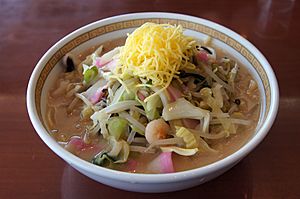
Nagasaki is known for its unique and delicious food, influenced by its history of foreign trade. Some popular dishes include:
- Tempura (deep-fried seafood and vegetables)
- Castella (a sweet sponge cake)
- Champon (a noodle dish with seafood and vegetables)
- Sara udon (crispy noodles with a topping)
- Shippoku Cuisine (a mix of Japanese, Chinese, and Western cooking styles)
- Toruko rice (Turkish rice)
- Nagasaki Kakuni (braised pork belly)
Famous People from Nagasaki
Many notable people have come from Nagasaki, including:
- Kazuo Ishiguro (Nobel Prize-winning author)
- Noboru Kaneko (actor)
- Takashi Nagai (doctor and author)
- Tsutomu Yamaguchi (survivor of both atomic bombings)
- Maya Yoshida (football player)
Sister Cities
Nagasaki has special "sister city" relationships with other cities around the world. These connections help promote friendship and cultural exchange.
 Hiroshima, Japan
Hiroshima, Japan St. Louis, United States (since 1972)
St. Louis, United States (since 1972) Saint Paul, United States (since 1955)
Saint Paul, United States (since 1955) Dupnitsa, Bulgaria
Dupnitsa, Bulgaria Santos, Brazil (since 1972)
Santos, Brazil (since 1972) Fuzhou, China (since 1980)
Fuzhou, China (since 1980) Middelburg, Netherlands (since 1978)
Middelburg, Netherlands (since 1978) Porto, Portugal (since 1978)
Porto, Portugal (since 1978) Vaux-sur-Aure, France (since 2005)
Vaux-sur-Aure, France (since 2005)
Images for kids
-
View of Dejima in Nagasaki Bay by Kawahara Keigo, around 1836.
See also
 In Spanish: Nagasaki para niños
In Spanish: Nagasaki para niños




